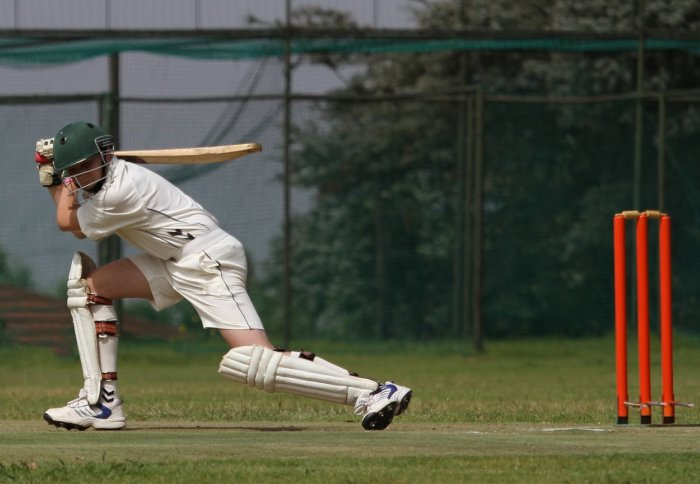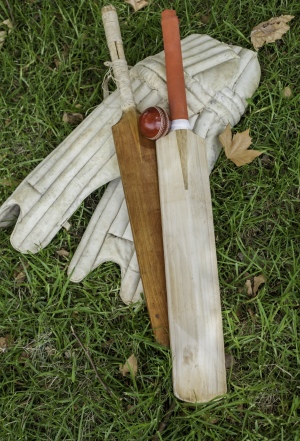Imperial research on bat designs bowls over MCC
by Colin Smith

The balance has been tipped in favour of the cricket bat, over the ball, engineers have found in an assessment of their design evolution.
The Marylebone Cricket Club (MCC), guardian of the Laws of Cricket, has previously gathered anecdotal evidence that suggested that bats have become significantly more powerful in recent years. There is also statistical evidence to support the view that the balance of the game has shifted from the bowler towards to the batsman. For example, the number of runs per six balls bowled in one day internationals -has increased steadily from 3.68 in the 1970s to 5.26 now.

Bat designers have very cleverly been able to increase bat performance over the years whilst remaining within the Laws of the Game
The researchers from Imperial College London have previously developed techniques to assess cricket bat performance and were commissioned by the MCC to carry out an assessment of five historical cricket bats, which dated back to 1905. The designs were by the same manufacturer and they all consisted of the same traditional materials including willow, cane and rubber. The research was carried out by Imperial engineers to assess if the changing design in cricket bats over the decades had altered the performance of the bats.
The team found that while the mass of the bat has increased over the years, it is the shape of the bat that makes the most significant difference to how far the ball can travel after it is hit.
The researchers found that the sweet spot has increased in size. It was 80 millimetres in 1905, increasing to 215 millimetres by 2013. This increase means a greater proportion of the bat is optimised to hit the ball harder. An increased sweet spot also minimises the vibration that the batsman experiences when hitting the ball and thus provides a better ‘feel’ to the bat.
The researchers also discovered that the thicker edges of modern bats mean that if a ball hits close to the bat’s edge, less energy is lost on impact, enabling the ball to travel further.

Professor Bull previously investigated how different cricket ball colours enable them to be more clearly seen in day-night matches
After considering the Imperial research, the MCC World Cricket committee recommended the introduction this week of further bat size limitations to the Laws of Cricket. The MCC is recommending limits to the edge, depth and possibly to the weight of the bat, beyond the limits that have long been in place regarding the width and length of a cricket bat. One proposal put forward by the MCC is for the maximum thickness of the edge to be between 35mm and 40mm, and the overall depth of the bat to be between 60mm and 65mm - some bats in current use have edges of 55mm and can be up to 80mm deep.
Professor Anthony Bull is a keen follower of cricket and occasional player. He has previously investigated how different cricket ball colours enable them to be more clearly seen in day-night matches, as part of a strategic collaboration between Imperial and the MCC. He has also developed new methods for recognising a No ball. This penalty is given to the fielding team, usually a result of an illegal delivery of the bowler. The assessment involves analysing how the bowler’s elbow moves during ball delivery.
Professor Bull carried out the current work along with Imperial graduates Theofano Eftaxiopoulou and Lomas Persad who are also from the Department of Bioengineering.
The current discussion in the cricketing world in relation to bat designs is that it may be getting too easy for batsmen to clear the boundary - in all levels of cricket. Discussions are also being had around safety concerns for close fielders, bowlers and umpires when the balls can be hit so far. The recreational game may also be suffering, as balls are flying into nearby residential properties with increasing frequency, which is threatening the existence of some smaller cricket clubs.
Professor Bull said: “We have shown that the cross sectional profile of a cricket bat is perhaps as important as its width, height and weight and that bat designers have very cleverly been able to increase bat performance over the years whilst remaining within the Laws of the Game. It is not for me to comment on the Laws, but I am delighted that the MCC has decided to base their new proposals on hard science. Being a lover of cricket I am delighted that our long-term collaboration is bringing positive benefits to the sport.”
Further consultations will be held with bat manufacturers and Imperial scientists to finalise the exact measurements, and the means of evaluating them, as well as to investigate the viability and need for a weight limit. Eventually an amended Law – subject to agreement and ratification by the Club's Main Committee – would be included as part of the new Code of Laws, currently being re-written by MCC. The new Code is scheduled to be introduced on 1st October 2017.
Article text (excluding photos or graphics) © Imperial College London.
Photos and graphics subject to third party copyright used with permission or © Imperial College London.
Reporter
Colin Smith
Communications and Public Affairs